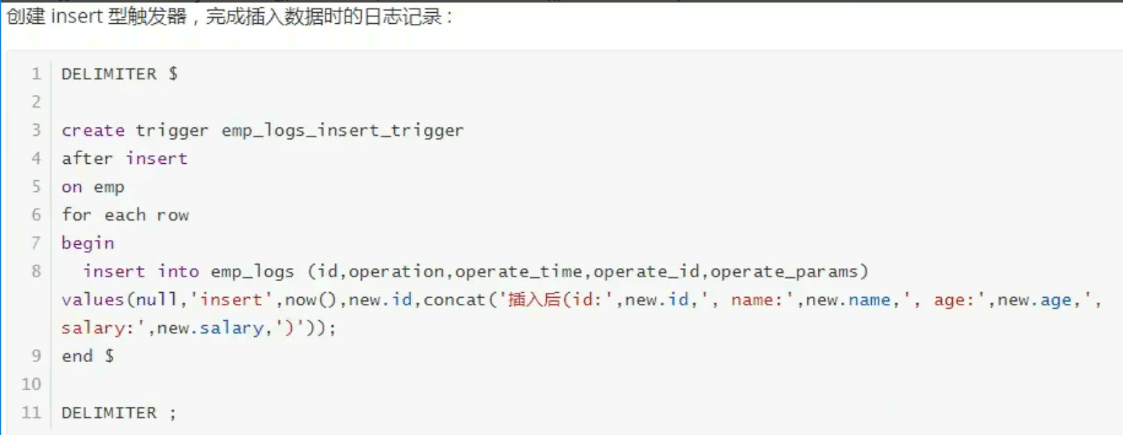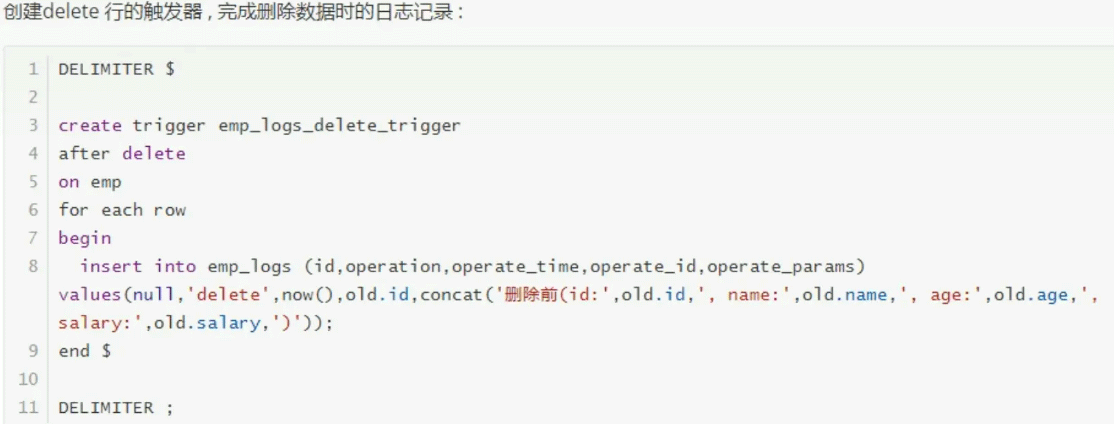How to customize functions and triggers in MySQL
1. Stored function (custom function)
Custom function is a way to extend MySQL, and its usage is the same as the built-in function.
Two necessary conditions for defining a function: parameters and return value. Functions can return values of any type and can also receive parameters of these types.
About the function body:
The function body is composed of legal SQL statements.
The function body can be a simple SELECT or INSERT statement.
If the function body conforms to the structure, it is wrapped with the BEGIN....AND statement.
Compound structures can contain declarations, loops, control structures, etc.
Important: Custom functions cannot have the same name, just like defining a global variable, the variable names cannot be consistent.
1.1 Define stored function
Syntax format:
create function 函数名(参数列表)
returns type(返回值类型)
begin
--SQL语句
end;Requirements: Define a function of a stored procedure, Get the total number of records that meet the conditions
Implementation:
delimiter $
create function fun(countryId int)
returns int
begin
# 定义一个存储总数据条数的变量
declare cum int default 0;
# 查询等于传递参数的全部的数据数,然后将其赋值给定义的变量
select count(*) into cum from city where country_id = countryId;
# 返回结果值。存储函数必须有返回值
return cum;
end $
delimiter ;1.2 Call the storage function
Syntax format:
select 函数名(参数列表);
Note: The call keyword is used when calling a stored procedure, but you can directly use select when calling a stored function, just like calling an ordinary aggregate function in MySQL.
select fun(1); # 这里和存储过程一样,调用的时候需要加小括号和参数,但是在删除的时候指定函数名即可
1.3 Delete stored function
Syntax format
drop [if exists] function fun;
2. Trigger
2.1 Trigger introduction
A trigger is a database object related to a table, which refers to triggering and executing the SQL set defined in the trigger before or after insert/update/delete. This feature of triggers can help applications ensure data integrity, logging, and data verification on the database side.
- Triggers can only be used when adding, deleting, or modifying, but not when querying.
- In triggers, use the OLD and NEW aliases to reference the changed parts of the record, similar to other databases. MySQL triggers only support row-level triggering and do not support statement-level triggering. Oracle supports both row-level and statement-level triggers.
- The two variables OLD and NEW are also called row record variables.
You can use these two variables to obtain the data in the data table to be operated.
 ##2.2 Create trigger
##2.2 Create trigger
create trigger(触发器) trigger_name(触发器名称)
before/after insert/update/delete
on tab_name(表名)
[for each row](行级触发器)
begin
trigger_stmt;(触发器的逻辑)
end;
Implementation:
Analysis:
A trigger can only operate one type of data operation, and cannot complete the operations of adding, modifying, and deleting at the same time. Therefore, multiple triggers need to be defined at this time to complete this logging task.
Because MySQL is a trigger for row-level operations, new and old store an entire row of data.Create a trigger to execute insert:

- In insert mode , use the keyword new to get the data to be inserted
- The after is used, and this trigger is executed to record the log after the addition of the table emp is completed.
- When this trigger is executed depends on two points:
- Must perform insert operation.
- Must operate It is the emp table, which is the table declared after on.

Create a trigger to execute delete:

Test: The test must be the emp table of the operation, so that the above will be triggered Defined trigger.
 2.3 Delete trigger
2.3 Delete trigger
drop trigger [schema_name.](数据库名)trigger_name(触发器名);
2.4 View triggers
You can view the status, syntax and other information of triggers by executing the show triggers command.
Grammar structure:The above is the detailed content of How to customize functions and triggers in MySQL. For more information, please follow other related articles on the PHP Chinese website!show triggers;

Hot AI Tools

Undresser.AI Undress
AI-powered app for creating realistic nude photos

AI Clothes Remover
Online AI tool for removing clothes from photos.

Undress AI Tool
Undress images for free

Clothoff.io
AI clothes remover

Video Face Swap
Swap faces in any video effortlessly with our completely free AI face swap tool!

Hot Article

Hot Tools

Notepad++7.3.1
Easy-to-use and free code editor

SublimeText3 Chinese version
Chinese version, very easy to use

Zend Studio 13.0.1
Powerful PHP integrated development environment

Dreamweaver CS6
Visual web development tools

SublimeText3 Mac version
God-level code editing software (SublimeText3)

Hot Topics
 1386
1386
 52
52
 MySQL: Simple Concepts for Easy Learning
Apr 10, 2025 am 09:29 AM
MySQL: Simple Concepts for Easy Learning
Apr 10, 2025 am 09:29 AM
MySQL is an open source relational database management system. 1) Create database and tables: Use the CREATEDATABASE and CREATETABLE commands. 2) Basic operations: INSERT, UPDATE, DELETE and SELECT. 3) Advanced operations: JOIN, subquery and transaction processing. 4) Debugging skills: Check syntax, data type and permissions. 5) Optimization suggestions: Use indexes, avoid SELECT* and use transactions.
 How to open phpmyadmin
Apr 10, 2025 pm 10:51 PM
How to open phpmyadmin
Apr 10, 2025 pm 10:51 PM
You can open phpMyAdmin through the following steps: 1. Log in to the website control panel; 2. Find and click the phpMyAdmin icon; 3. Enter MySQL credentials; 4. Click "Login".
 MySQL: An Introduction to the World's Most Popular Database
Apr 12, 2025 am 12:18 AM
MySQL: An Introduction to the World's Most Popular Database
Apr 12, 2025 am 12:18 AM
MySQL is an open source relational database management system, mainly used to store and retrieve data quickly and reliably. Its working principle includes client requests, query resolution, execution of queries and return results. Examples of usage include creating tables, inserting and querying data, and advanced features such as JOIN operations. Common errors involve SQL syntax, data types, and permissions, and optimization suggestions include the use of indexes, optimized queries, and partitioning of tables.
 How to use single threaded redis
Apr 10, 2025 pm 07:12 PM
How to use single threaded redis
Apr 10, 2025 pm 07:12 PM
Redis uses a single threaded architecture to provide high performance, simplicity, and consistency. It utilizes I/O multiplexing, event loops, non-blocking I/O, and shared memory to improve concurrency, but with limitations of concurrency limitations, single point of failure, and unsuitable for write-intensive workloads.
 Why Use MySQL? Benefits and Advantages
Apr 12, 2025 am 12:17 AM
Why Use MySQL? Benefits and Advantages
Apr 12, 2025 am 12:17 AM
MySQL is chosen for its performance, reliability, ease of use, and community support. 1.MySQL provides efficient data storage and retrieval functions, supporting multiple data types and advanced query operations. 2. Adopt client-server architecture and multiple storage engines to support transaction and query optimization. 3. Easy to use, supports a variety of operating systems and programming languages. 4. Have strong community support and provide rich resources and solutions.
 MySQL's Place: Databases and Programming
Apr 13, 2025 am 12:18 AM
MySQL's Place: Databases and Programming
Apr 13, 2025 am 12:18 AM
MySQL's position in databases and programming is very important. It is an open source relational database management system that is widely used in various application scenarios. 1) MySQL provides efficient data storage, organization and retrieval functions, supporting Web, mobile and enterprise-level systems. 2) It uses a client-server architecture, supports multiple storage engines and index optimization. 3) Basic usages include creating tables and inserting data, and advanced usages involve multi-table JOINs and complex queries. 4) Frequently asked questions such as SQL syntax errors and performance issues can be debugged through the EXPLAIN command and slow query log. 5) Performance optimization methods include rational use of indexes, optimized query and use of caches. Best practices include using transactions and PreparedStatemen
 MySQL and SQL: Essential Skills for Developers
Apr 10, 2025 am 09:30 AM
MySQL and SQL: Essential Skills for Developers
Apr 10, 2025 am 09:30 AM
MySQL and SQL are essential skills for developers. 1.MySQL is an open source relational database management system, and SQL is the standard language used to manage and operate databases. 2.MySQL supports multiple storage engines through efficient data storage and retrieval functions, and SQL completes complex data operations through simple statements. 3. Examples of usage include basic queries and advanced queries, such as filtering and sorting by condition. 4. Common errors include syntax errors and performance issues, which can be optimized by checking SQL statements and using EXPLAIN commands. 5. Performance optimization techniques include using indexes, avoiding full table scanning, optimizing JOIN operations and improving code readability.
 Monitor Redis Droplet with Redis Exporter Service
Apr 10, 2025 pm 01:36 PM
Monitor Redis Droplet with Redis Exporter Service
Apr 10, 2025 pm 01:36 PM
Effective monitoring of Redis databases is critical to maintaining optimal performance, identifying potential bottlenecks, and ensuring overall system reliability. Redis Exporter Service is a powerful utility designed to monitor Redis databases using Prometheus. This tutorial will guide you through the complete setup and configuration of Redis Exporter Service, ensuring you seamlessly build monitoring solutions. By studying this tutorial, you will achieve fully operational monitoring settings




